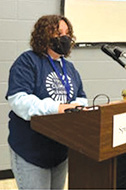
Keila speaks at the Western MA Youth Clinate Summit at Springfield College.
To say that Keila Silva, Suffield High School Junior, has been busy is an understatement. Not only is she an honors student, Keila also serves as a student leader on SHS’s Suffield Sustainability Council, is the student liaison for the Suffield Board of Education, Sustainable Suffield’s Student Representative, a leader of the Western Massachusetts Youth Climate Leadership Program, an award recipient in UConn’s Natural Resources Conservation Ambassador program, and has been engaged as a youth speaker by the Connecticut Land Conservation Council, the Connecticut Outdoor and Environmental Educators Association, and the Massachusetts Environmental Education Society.
To add to all of this, she just won $5000 as a semifinalist in EcoAmerica’s American Youth Climate Leadership Award. I sat down with Keila to find out more about her impressive work as a youth environmentalist.
In a relatively short amount of time, you have had an incredible diversity of experiences related to the environment. What led you to this as an area of interest?
Growing up, I witnessed the natural disasters which devastated Puerto Rico. Despite not being Puerto Rican (even though I am bi-racial, white and Latina), my heart ached for this community because I knew those who were the most vulnerable would not receive the aid vital to saving them. Subsequently, as I matured in age I became drawn to environmental justice/EJ (the intersection of human rights and environmental protection).
Who are your role models?
One of the most important role models to me would be Justin Kaput, the K-12 Science Curriculum coach. Freshman year he introduced me to the concept of EJ and connected me with the Suffield Sustainability Council (SSC), which led me to meet other mentors of mine like Doris Johnson, (Outreach and Education Coordinator for CT DEEP’s Environmental Justice program) and Dr. John Francis, the inspiration for 2022’s Walk to the Hart. In addition, another role model of mine is Brittany Guttermuth from MA Audubon who runs the Youth Climate Leadership Program.
Considering all the energy you have put into bettering the environment, where do you hope to see Suffield in five years?
In terms of the town, I hope to see it become more inclusive towards the marginalized groups which reside here and for groups like Sustainable Suffield to put energy into topics like EJ – and not just typical environmental topics like waste and recycling. Those topics are important, however they miss vital social aspects, like, ‘how does climate change affect people in Suffield differently?’ Community is everyone, and we need to think about these kinds of issues more broadly. In terms of the high school, it needs to become a more inclusive place too. Youth obtain their values from adults and other role models in their lives, and like Dr. Francis says, people need to be kinder to each other.
Your award is for work on the Walk to the Hart event. Is there anything in particular you would like to say about that?
Walk to the Hart (WTTH) was trying to convey that the climate crisis is a problem we can work on together. This message is reflected in the entirety of planning Walk to the Hart. Around 40 students came together to make a difference, and we showed solidarity too – we may have been different, some from different communities (Suffield Students trained students from eight communities on day 2 at Northwest Park) or had more or less money, but we still were able to unite to create changes in our towns. It was chaos to plan it, but it brought so much joy to those of us who worked on it.
How did WTTH affect you personally?
It introduced me to a whole new field. I didn’t really like science before, but WTTH opened my eyes. Science is a place where people and community come together, it drives our conclusions and how we move forward. People can rally behind important data, and when it gets communicated effectively we can make significant changes. WTTH showed us what youth needing help looks like, but even more so it shows what us moving forward looks like. I think the legacy of WTTH really was its mission, and that needs to live on – we are the environment. I hope that this message of inclusivity, sustainability, and intersectionality becomes more than just the message of an event. It needs to be the theme of Suffield.
Any shout outs?
Most importantly to my Uma (grandmother) since she has been by my side throughout the course of all I have done as my chauffeur. Without her, my Dad, Da (grandfather), and Aunt, I couldn’t have risen to such unexpected heights – because they are my rock. Finally, I want to thank SHS administration, my teachers, and my partners on SSC for helping me navigate my academic and professional responsibilities when they overlap.